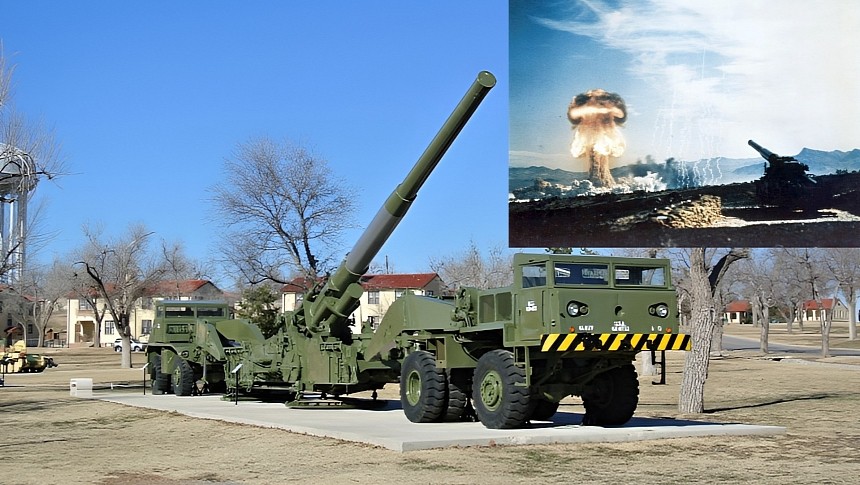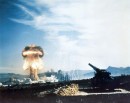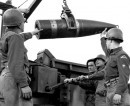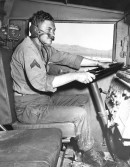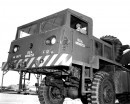You might rest better at night thinking the U.S. Military has a good handle on what is and what isn't a bad idea in a combat setting. Should America and its NATO allies start wrestling in the mud with a powerful hostile aggressor, we'd hope to the lord almighty that's the case. But as is evident by the existence of the M65 Atomic Cannon, this is only sometimes true. Today, we're taking a deep dive into a motorized cannon and tractor that fired just a single nuclear artillery shell before the Pentagon just went, "Nope," and never attempted it again.
The story behind the artillery system that came to be nicknamed "Atomic Annie" is one rooted in the nuclear craze post-World War II. A period in which the novelty of harnessable atomic fission had the world convinced that nuclear was the way forward, both in the commercial energy sector and in warfare. With this in mind, the United States aimed to capitalize on being the world's only nuclear-armed superpower in the four years between 1945 and 1949. Everything from the blueprints for the U.S.'s first commercial reactor in Shippingport, Pennsylvania, to the world's first thermonuclear hydrogen bomb had their origins during this period, only to be followed through on in the following decade.
In the atomic craze following the war's end, so many of America's most skilled and battle-tested military contractors dropped whatever they were doing during the war and started developing the next generation of nuclear weapons and the vehicular platforms to transport them. It was a Pentagon-affiliated computer engineer by the name of Robert Schwartz who devised a plan that sounded great on paper to your average 12-year-old in hindsight.
But without the benefit of hindsight to guide him, Schwartz envisioned a weapon based loosely upon the American M1 240 mm howitzer employed by the U.S. Army in the European and Pacific theaters of World War II. Both the M1 and Schartz's derivative were designed with a degree of mobility in mind. Both platforms employed their own truck-based transportation system, like the Mack NO 7½-ton 6x6 truck in the case of the M1. But Robert Schwartz's design was so much more than just another big artillery piece, as its payload was a little extra "spicy" compared to what most were accustomed to.
That's right, Schwartz's grand plan was to develop and manufacture the first artillery device built specifically to fire nuclear weapons. If that sounds absolutely bat-you-know-what to most modern sensibilities, you're not in the wrong. But, because nothing was off the table in the early days of the atomic era, Schwartz's project was approved by the Joint Chiefs of Staff of the Harry S. Truman administration and the Pentagon.
Indeed, another Pentagon computer scientist named Samuel Feltman was also instrumental in formulating the basis for a nuclear cannon. It was he, with Robert Schwartz's help, that helped secure the design and production rights for the M65 system for military contractors across America. This included the Picatinny Arsenal of Morris County in Northern New Jersey, roughly 30 miles from New York City.
No sooner did the 1940s come to an end than the design phase for the M65 was underway. Starting at the Picatinny Arsenal and finishing at the Watervliet Arsenal, along the banks of the Hudson River near Albany, New York. By effectively re-engineering the old M1 240 mm artillery piece into a 280 mm leviathan, the new platform, dubbed the T131 at first, was able to accept the world's first nuclear artillery shell, the W9. Only the second gun-type nuclear weapon ever tested behind the Little Boy bomb that flattened Hiroshima, the 15-kiloton yield shell weighed just 850 lbs (390 kg). Far smaller than more traditional aircraft-dropped nuclear payloads like Little Boy and Fat Man, but still enough to pack a devastating punch on any target it hit.
Such an enormous artillery piece could only be transported with the help of two purpose-built trucks tailor-made for the job of lugging the great beast around. A product of the iconic Kenworth Motor Truck Company, the front and rear transport tractors were massive in their own right. Weighing in at 7,950 lbs (17,191 kg 19 tons) in the M249 4x4 Heavy Gun Front Truck and 35,910 lbs( 16,267 kg 18 tons) for the M250 Rear Truck. Each of the 33 front and rear transport trucks sported a Continental AO-895-4 six-cylinder diesel engine cranking out 375 horsepower. Not bad for the early 1950s.
When all assembled, the two tractors plus the 38-foot, five-inch (11.31-m) long monster of a machine weighed a scarcely believable 172,865 lbs (78,308 kg, 86.4 tons). In truth, this weapon system was seen as three separate elements, with the artillery cannon portion dubbed the T131 while both transport tractors were jointly called the T72 Gun Carriage. Only when all three elements were combined was the M65 Atomic Cannon complete. Said system could traverse along, albeit clumsily, at around 35 mph on smooth and level tarmac. It could also make right-angle turns with at least a 28-foot (8.5 m) birth on either side.
Impressively for such a huge weapon, U.S. Army ground crews could detach the T131 cannon from its twin tractors ready for operation in as little as 12 minutes before packing it up and re-attaching its tractors in as little as 15 minutes with a five-to-seven-man crew. As many as 20 T131 artillery pieces were manufactured during its production run. Said manufacturing took place at the Dravo Corporation's production facility in Pittsburgh, Pennsylvania, as well as the above-mentioned Watervliet Arsenal and the Watertown Arsenal in Eastern Massachusetts.
Ultimately, these M65 Atomic Cannon systems were sent to testing facilities in West Germany, South Korea, and the U.S.-occupied Pacific Island of Okinawa. But only after one was sent to the Nevada National Security Site, then known as the Nevada Proving Grounds, around 65 miles (105 km) northwest of Las Vegas. It was at this location on May 25, 1953, during a round of nuclear tests dubbed Operation Upshot-Knothole, that a complete M65 Atomic Cannon was loaded with a W9 nuclear shell and pointed at a target roughly seven miles (11 km) away.
At 8:30 in the morning, a single W9 nuclear shell was fired and air-burst roughly 524 feet (160 m) above the ground, within a mere 24 feet (7 m) of its intended target height over a stretch of the test sight designated Area 5, or Frenchman Flat. This caused a great flash of light and an iconic atomic mushroom cloud rising towards the heavens with great haste. With powerful Pentagon figures in the audience, like then Secretary of Defense Charles Erwin Wilson and Admiral Arthur W. Radford, Chairman-delegate of the Joint Chiefs of Staff, the M65, nicknamed Atomic Annie, had made an indelible effect on all who witnessed the great blast.
With funding for the project at $800,000 per complete M65 unit now secured, each of them was free to be transported to U.S. bases across the globe to be used as a deterrent against hostile nations like the USSR and North Korea. But seemingly, as soon as the platform was operational, the M65 was all but obsolete. With novel nuclear-payload delivery systems like the B-52 Stratofortress bomber and the MGR-1 Honest John surface-to-surface rocket waiting in the wing, it was clear that a shell-based nuclear delivery system wasn't the way forward in American nuclear weapons.
To the big-wigs at the Pentagon, the risks of collateral damage and potential danger to the crew of an atomic artillery piece weren't outweighed by its benefits. After all, Atomic Annie's warhead had a yield barely more powerful than the weapon used during the bombing of Hiroshima. In the barely-contained nuclear fervor of U.S.-Soviet brinkmanship, that simply wasn't going to be enough. Sheesh, doesn't it feel like everyone in the Cold War ironically needed a chill pill? Though a nuclear artillery shell has never been fired from a cannon since 1953, successors to the W9 warhead continued to be designed but were never fired from an artillery piece.
Some of the larger shells in this lineage, like the W23, were designed to be fired from the massive 16-inch main cannons of Iowa-class battleships. A theoretically awesome concept if you're a child, but good luck trying to limit collateral damage with a screaming 16-inch nuclear projectile coming at your face with a rocking sea to contend with. Today, while ballistic missiles continue to fill the role the M65 was built for, at least seven T131 cannons reside in museums across North America. The particular example that fired the infamous nuclear shell resides with its prime movers at the Army Artillery Museum in Fort Sill, Oklahoma.
In the atomic craze following the war's end, so many of America's most skilled and battle-tested military contractors dropped whatever they were doing during the war and started developing the next generation of nuclear weapons and the vehicular platforms to transport them. It was a Pentagon-affiliated computer engineer by the name of Robert Schwartz who devised a plan that sounded great on paper to your average 12-year-old in hindsight.
But without the benefit of hindsight to guide him, Schwartz envisioned a weapon based loosely upon the American M1 240 mm howitzer employed by the U.S. Army in the European and Pacific theaters of World War II. Both the M1 and Schartz's derivative were designed with a degree of mobility in mind. Both platforms employed their own truck-based transportation system, like the Mack NO 7½-ton 6x6 truck in the case of the M1. But Robert Schwartz's design was so much more than just another big artillery piece, as its payload was a little extra "spicy" compared to what most were accustomed to.
That's right, Schwartz's grand plan was to develop and manufacture the first artillery device built specifically to fire nuclear weapons. If that sounds absolutely bat-you-know-what to most modern sensibilities, you're not in the wrong. But, because nothing was off the table in the early days of the atomic era, Schwartz's project was approved by the Joint Chiefs of Staff of the Harry S. Truman administration and the Pentagon.
No sooner did the 1940s come to an end than the design phase for the M65 was underway. Starting at the Picatinny Arsenal and finishing at the Watervliet Arsenal, along the banks of the Hudson River near Albany, New York. By effectively re-engineering the old M1 240 mm artillery piece into a 280 mm leviathan, the new platform, dubbed the T131 at first, was able to accept the world's first nuclear artillery shell, the W9. Only the second gun-type nuclear weapon ever tested behind the Little Boy bomb that flattened Hiroshima, the 15-kiloton yield shell weighed just 850 lbs (390 kg). Far smaller than more traditional aircraft-dropped nuclear payloads like Little Boy and Fat Man, but still enough to pack a devastating punch on any target it hit.
Such an enormous artillery piece could only be transported with the help of two purpose-built trucks tailor-made for the job of lugging the great beast around. A product of the iconic Kenworth Motor Truck Company, the front and rear transport tractors were massive in their own right. Weighing in at 7,950 lbs (17,191 kg 19 tons) in the M249 4x4 Heavy Gun Front Truck and 35,910 lbs( 16,267 kg 18 tons) for the M250 Rear Truck. Each of the 33 front and rear transport trucks sported a Continental AO-895-4 six-cylinder diesel engine cranking out 375 horsepower. Not bad for the early 1950s.
When all assembled, the two tractors plus the 38-foot, five-inch (11.31-m) long monster of a machine weighed a scarcely believable 172,865 lbs (78,308 kg, 86.4 tons). In truth, this weapon system was seen as three separate elements, with the artillery cannon portion dubbed the T131 while both transport tractors were jointly called the T72 Gun Carriage. Only when all three elements were combined was the M65 Atomic Cannon complete. Said system could traverse along, albeit clumsily, at around 35 mph on smooth and level tarmac. It could also make right-angle turns with at least a 28-foot (8.5 m) birth on either side.
Ultimately, these M65 Atomic Cannon systems were sent to testing facilities in West Germany, South Korea, and the U.S.-occupied Pacific Island of Okinawa. But only after one was sent to the Nevada National Security Site, then known as the Nevada Proving Grounds, around 65 miles (105 km) northwest of Las Vegas. It was at this location on May 25, 1953, during a round of nuclear tests dubbed Operation Upshot-Knothole, that a complete M65 Atomic Cannon was loaded with a W9 nuclear shell and pointed at a target roughly seven miles (11 km) away.
At 8:30 in the morning, a single W9 nuclear shell was fired and air-burst roughly 524 feet (160 m) above the ground, within a mere 24 feet (7 m) of its intended target height over a stretch of the test sight designated Area 5, or Frenchman Flat. This caused a great flash of light and an iconic atomic mushroom cloud rising towards the heavens with great haste. With powerful Pentagon figures in the audience, like then Secretary of Defense Charles Erwin Wilson and Admiral Arthur W. Radford, Chairman-delegate of the Joint Chiefs of Staff, the M65, nicknamed Atomic Annie, had made an indelible effect on all who witnessed the great blast.
With funding for the project at $800,000 per complete M65 unit now secured, each of them was free to be transported to U.S. bases across the globe to be used as a deterrent against hostile nations like the USSR and North Korea. But seemingly, as soon as the platform was operational, the M65 was all but obsolete. With novel nuclear-payload delivery systems like the B-52 Stratofortress bomber and the MGR-1 Honest John surface-to-surface rocket waiting in the wing, it was clear that a shell-based nuclear delivery system wasn't the way forward in American nuclear weapons.
Some of the larger shells in this lineage, like the W23, were designed to be fired from the massive 16-inch main cannons of Iowa-class battleships. A theoretically awesome concept if you're a child, but good luck trying to limit collateral damage with a screaming 16-inch nuclear projectile coming at your face with a rocking sea to contend with. Today, while ballistic missiles continue to fill the role the M65 was built for, at least seven T131 cannons reside in museums across North America. The particular example that fired the infamous nuclear shell resides with its prime movers at the Army Artillery Museum in Fort Sill, Oklahoma.
